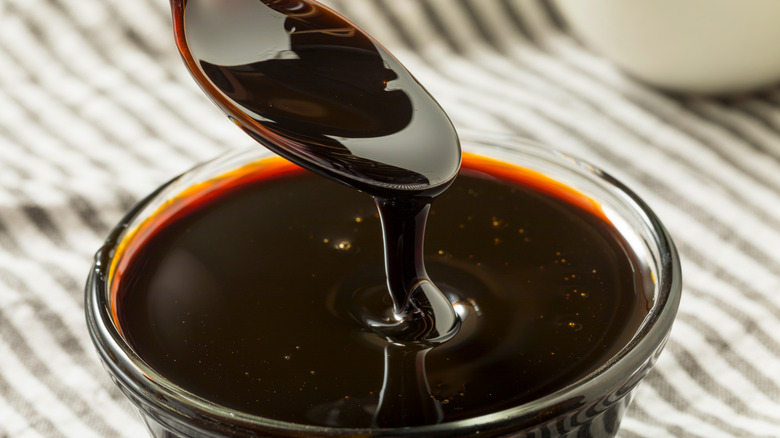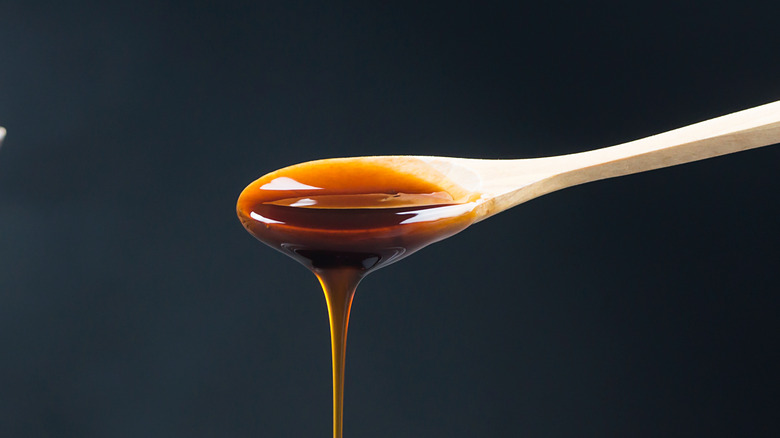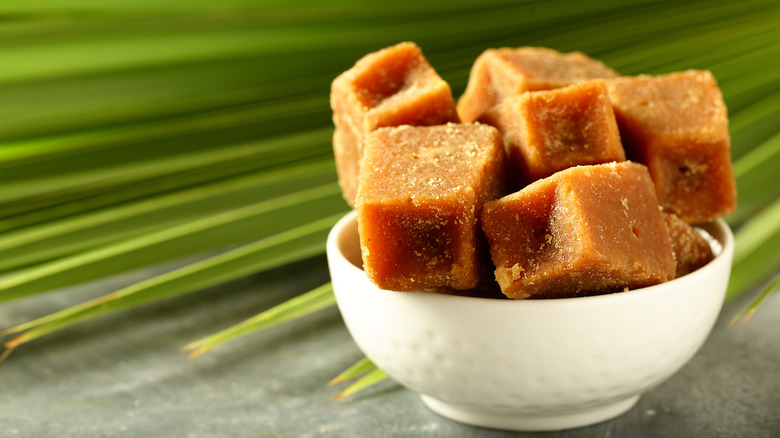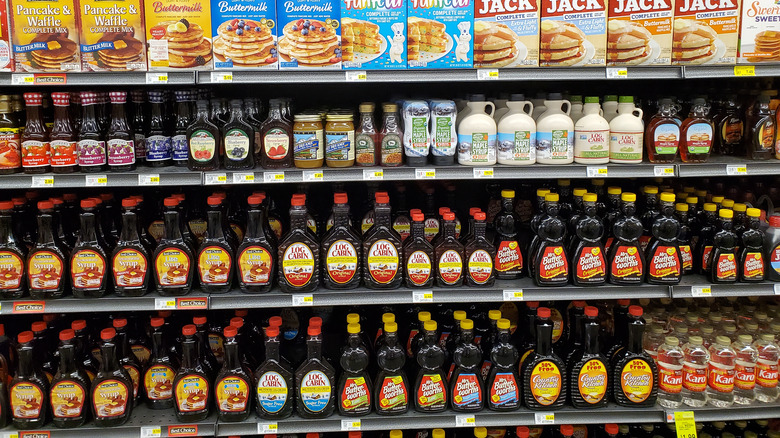What Is Kithul Syrup And What Is It Made Of?
We may receive a commission on purchases made from links.
Kithul syrup is a sweet, viscous, dark brown liquid that is created by harvesting sap from the kithul palm, or the Caryota urens palm tree (via USDA), and then boiling it down into a concentrated and sugary syrup that is used for flavoring foods, for producing candies, and traditionally, played a role in Ayurvedic medicine as well (via Grocery Lanka). In that kithul syrup is created by tapping a tree, collecting its sap, and then boiling it down into a concentrated and sugary form, it is arguably most similar to its better-known counterpart, maple syrup. In appearance and flavor, however, kithul syrup, often also known as kithul treacle, is more similar to molasses, the sweet syrup created by boiling sugar cane extract with sugar crystals removed.
Kithulm syrup, a product primarily from Sri Lanka, is collected by skilled workers who by in large use generations-old techniques to produce the sweet liquid. According to NPR, a single kithul palm tree can take 15 years to grow to a state and size mature enough to produce sap. (The tree is also known as the fishtail palm, toddy palm, sago palm, and jaggery palm — note that last name in particular for later clarification.) When the trees are ready, a worker will ascend the trunk via narrow ladder, often climbing more than 40 feet up off the ground, and will then use a knife to make a series of cuts in the trunk, scoring it just below the flowers clustered near the crown of the palm. Below these cuts, the worker secures a collection sack which will slowly fill with the oozing sap. This sap is then boiled for many hours until the desired consistency and sweetness is reached.
What does kithul syrup taste like?
In a word, kithul syrup is sweet. It is used in place of sugar or other sweeteners in baked goods, in smoothies, it is drizzled over pancakes and waffles, it's served on ice cream, and it is used in myriad other ways to sweeten all sorts of dishes common in Sri Lankan cuisine and beyond (via NPR). The flavor itself is described as "woody, floral, smoky, and even savory" and the degree of sweetness varies depending on the darkness of the syrup — as with molasses, the darker the coloring (and the thicker the syrup's consistency), the less sweet and the more smoky the taste, while lighter, more honey-colored syrups tend to be sweeter in taste and thinner in viscosity.
Often called "kithul honey" and often compared to maple syrup in flavor, ultimately kithul syrup boasts a unique flavor that needs to be tried to be fully appreciated. That is also true for some of the products into which the sweet syrup can be further refined.
What is jaggery and is it healthier than syrup?
Jaggery is one of the most common terms for the semi-refined sugar that is sourced from the kithul, coconut, or date palm tree's sap, though it can also be produced from a few other types of tree or plant, such as sugar cane, according to Huffington Post. Production begins in just the same manner as with kithul syrup: the sap (or cane extract) is harvested and then boiled down into a concentrated, sweet, thick syrup. Impurities are strained out and the cooking down process continues to the point at which a syrup begins to thicken into a sort of sticky dough, according to Healthline.
This thick, sweet dough is then portioned out, often into molds, and allowed to cool. The resulting foodstuff is jaggery, which is called gar in India, piloncillo in Mexico, kokuto in Japan, and goes by myriad other names around the globe. It is essentially a hunk (or molded piece) of unrefined sugar which can be eaten as-is like a candy treat or can be used in all manner of recipes as a sugar alternative, and as a relatively healthier alternative at that.
According to Healthline, a half cup serving of jaggery can deliver more than half of your daily needed iron, 20 percent of your daily needed magnesium, and 30 percent of your daily needed potassium. That all said, it is hardly a low calorie food, with that same serving packing in nearly 400 calories.
Where can you buy kithul syrup?
Unless you are shopping at a grocery store in Sri Lanka, or else you have a very specialized market near your house, you will usually be hard pressed to find kithul syrup at any of the shops nearby. But you can order kithul syrup online and can usually find it with relative ease. In cost, kithul syrup is usually comparable to maple syrup, and as with all products, buying in bulk saves you cash.
You can also usually find kithul jaggery for sale online, and again, it is a relatively affordable product despite the long journey it must take from harvest and production on an island in the Indian Ocean and its having been shipped around the globe.
If you are interested in trying kithul syrup, don't put off doing so for too long: There are legitimate concerns that it may soon become an even scarcer and rarer commodity as fewer and fewer Sri Lankans turn to a career harvesting and refining the sap of the kithul tree, choosing instead jobs in business, tech, banking, and so on, according to NPR. The time-honored traditions and the skills and knowledge needed to produce kithul syrup are simply not as of much interest to the next generation of people who live where the kithul palm trees grow.



